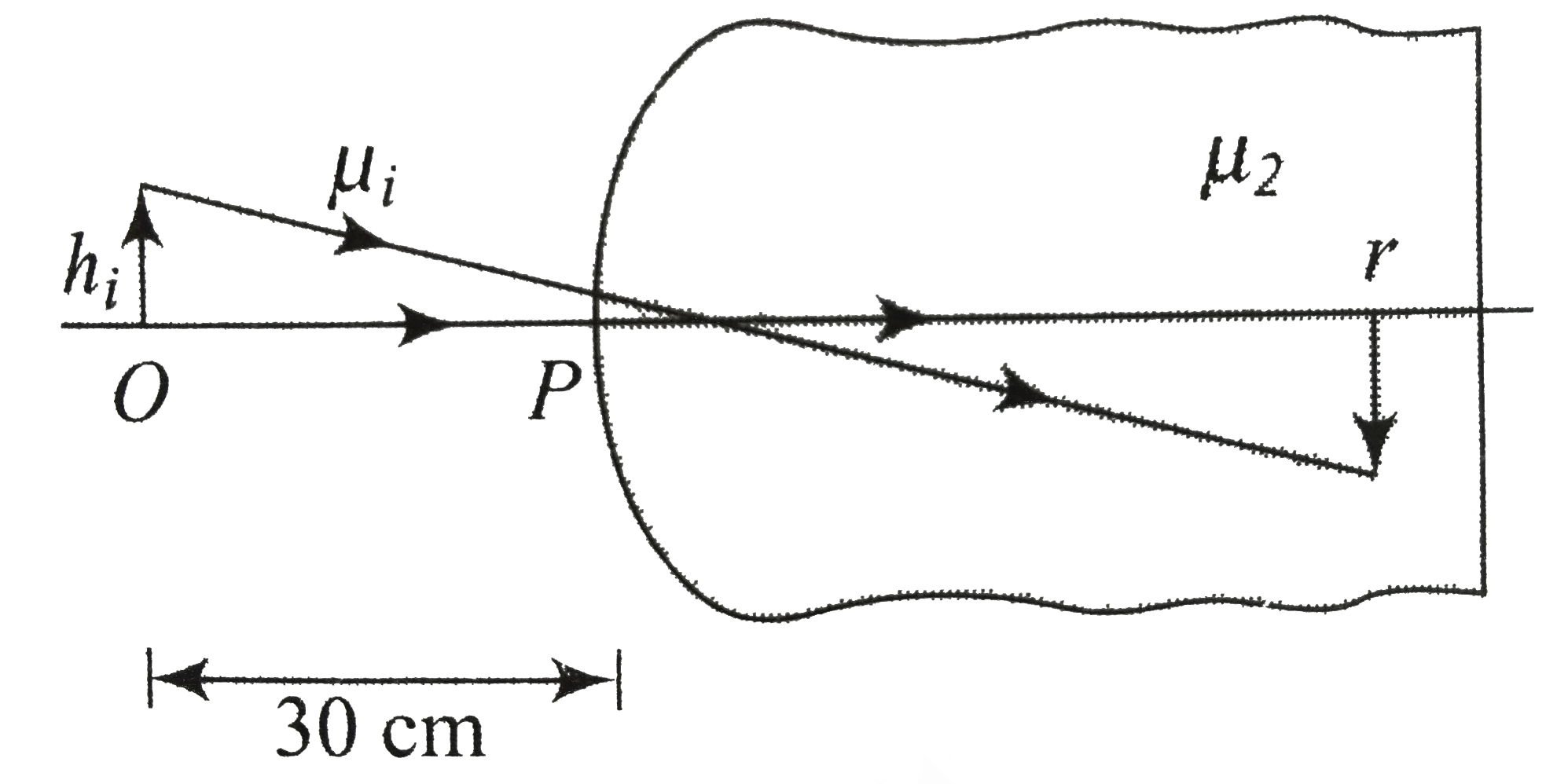One end of a long glass rod (μ=1.5) is formed into a convex surface of radius 6.0cm. An object is positioned in air along the axis of the rod. Find the image positions corresponding to object distances of (a) 20.0cm, (b) 10.0cm, (c) 3.0cm from the end of the rod.
The correct Answer is:A, B, C, D
To solve the problem, we will use the refraction formula for a spherical surface, which is given by:
μ2V−μ1U=μ2−μ1R
Where:
- μ1 is the refractive index of air (approximately 1.0),
- μ2 is the refractive index of glass (1.5),
- U is the object distance (taken as negative in this case),
- V is the image distance,
- R is the radius of curvature (positive for a convex surface).
Given:
- R=6.0cm
- μ1=1.0
- μ2=1.5
1. Set Up the Refraction Equation:
1.5V−1.0−D=1.5−1.06
Simplifying this gives:
1.5V+1.0D=0.56
Which can be rewritten as:
1.5V+1.0D=112
2. Rearranging the Equation:
1.5V=112−1.0D
V=1.5112−1.0D
3. Calculate Image Distances for Each Object Distance:
(a) For D=20.0cm:
V1=1.5112−1.020=1.5560−360=1.5260=1.5×602=45cm
(b) For D=10.0cm:
V2=1.5112−1.010=1.5560−660=1.5−160=−90cm
(c) For D=3.0cm:
V3=1.5112−1.03=1.5560−2060=1.5−1560=−6cm
Final Results
- For D=20.0cm, V1=45cm
- For D=10.0cm, V2=−90cm
- For D=3.0cm, V3=−6cm
- μ1 is the refractive index of air (approximately 1.0),
- μ2 is the refractive index of glass (1.5),
- U is the object distance (taken as negative in this case),
- V is the image distance,
- R is the radius of curvature (positive for a convex surface).
- R=6.0cm
- μ1=1.0
- μ2=1.5
1.5V−1.0−D=1.5−1.06
Simplifying this gives:
1.5V+1.0D=0.56
Which can be rewritten as:
1.5V+1.0D=112
1.5V=112−1.0D
V=1.5112−1.0D
V1=1.5112−1.020=1.5560−360=1.5260=1.5×602=45cm
V2=1.5112−1.010=1.5560−660=1.5−160=−90cm
V3=1.5112−1.03=1.5560−2060=1.5−1560=−6cm
- For D=20.0cm, V1=45cm
- For D=10.0cm, V2=−90cm
- For D=3.0cm, V3=−6cm
Topper's Solved these Questions
- REFRACTION OF LIGHTBOOK - DC PANDEY ENGLISHCHAPTER - REFRACTION OF LIGHTEXERCISE - Exercise 31.6
12 Videos
- REFRACTION OF LIGHTBOOK - DC PANDEY ENGLISHCHAPTER - REFRACTION OF LIGHTEXERCISE - Exercise 31.7
2 Videos
- REFRACTION OF LIGHTBOOK - DC PANDEY ENGLISHCHAPTER - REFRACTION OF LIGHTEXERCISE - Exercise 31.4
1 Videos
- REFLECTION OF LIGHTBOOK - DC PANDEY ENGLISHCHAPTER - REFLECTION OF LIGHTEXERCISE - Subjective
9 Videos
- SEMICONDUCTORSBOOK - DC PANDEY ENGLISHCHAPTER - SEMICONDUCTORSEXERCISE - Subjective
12 Videos
Similar Questions
Assume that a certain spherical mirror has a focal length of -10.0 cm. Locate and describe the
image for object distances of (a) 25.0 cm (b) 10.0 cm (c) 5.0 cm.
View SolutionOne end of a cylindrical glass rod (mu = 1.5) of radius 1.0 cm is rounded in the shape of a hemisphere. The rod is immersed in water (mu= 4/3) and an object is placed in the water along the axis of the rod at a distance of 8.0 cm from the rounded edge. Locate the image of the object.
View SolutionA convex mirror has its radius of curvature 20 cm. Find the position of the image of an object placed at a distance of 12 cm from the mirror.

View SolutionAn object is placed at a distance of 12 cm from a convex lens of focal length 8 cm. Find :
the position of the image
View SolutionOne end of a horizontal cylindrical glass rod (μ=1.5) of radius 5.0 cm is rounded in the shape of a hemisphere. An object 0.5 mm high is placed perpendicular to the axis of the rod at a difference of 20.0 cm from the rounded edge. Locate the image of the object and find its height.
View SolutionTwo thin lenses, both of 10 cm focal length- one convex and other concave, are placed 5 cm apart. An object is placed 20 cm in front of the convex lens. Find the nature and position of the final image.
View SolutionThe image of a real object in a convex mirror is 4cm from the mirror. If the mirror has a radius of curvature of 24cm, Find the position of object and magnification
View SolutionA lens with a focal length of 16cm produces a sharp image of an object in two positions, which are 60cm apart. Find the distance from the object to the screen.
View SolutionA small object of height 0.5 cm is placed in front of a convex surface of glass (μ−1.5) of radius of curvature 10cm. Find the height of the image formed in glass.

View SolutionAn object 5.0cm in length is placed at a distance of 20cm in front of a convex mirror of radius of curvature 30cm. Find the position of image, its nature and size.
View Solution
